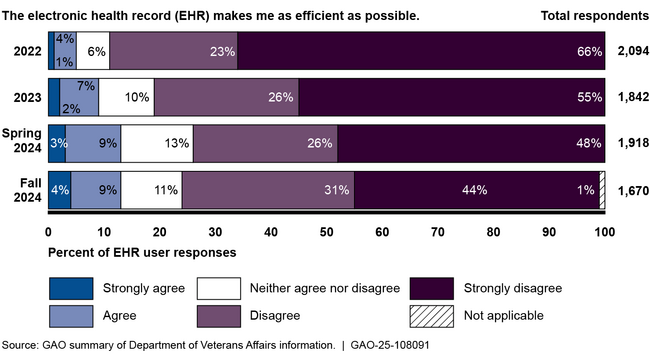Electronic Health Record Modernization: VA is Making Incremental Improvements, but Much More Remains to Be Done
Fast Facts
The Department of Veterans Affairs uses an electronic health record system to manage patient care. VA began to deploy its modernized system in 2020, but user concerns led to a pause in 2023.
We testified about our work on VA's system modernization. VA has made progress but more is needed, including:
Addressing over 1,800 requested configuration changes to the system
Updating the cost estimate and schedule to reflect the pause and work that remains
Addressing continued user dissatisfaction with the new system
We have multiple recommendations that VA still needs to implement to improve its electronic health record system.

Highlights
What GAO Found
From June 2020 to May 2023, GAO issued four reports on the Department of Veterans Affairs' (VA) efforts to implement its electronic health record modernization (EHRM) and made a total of 15 recommendations aimed at improving implementation. Among other things, these recommendations addressed poor user satisfaction, the need for better change management, the pace of system trouble ticket resolution, and the importance of addressing independent operational assessment deficiencies.
Most recently, in its draft report currently at VA for comment, GAO's preliminary results show that VA is making incremental improvements. This includes implementing over 1,500 system configuration changes and initiating projects to address user challenges. However, much more remains to be done:
As of February 2025, VA had not addressed approximately 1,800 complex configuration change requests.
The program lacks an updated total life cycle cost estimate that reflects the many EHRM changes and delays. Existing EHRM life cycle cost estimates range from VA's $16.1 billion to an independent estimate of $49.8 billion. Updating the independent life cycle cost estimate is imperative to understanding the full magnitude of VA's investment.
Similarly, it is critically important that VA update its integrated schedule to inform decision-making. Planned system deployment at four additional locations results in about 160 medical centers (94 percent of VA's total number of medical centers) without the new system as of mid-2026.
The EHRM program did not identify baselines and targets for one of its nine metrics to measure the impact of the new system at the live sites.
VA's 2024 user surveys continue to reflect general dissatisfaction with the new system. (See figure.)
Department of Veterans Affairs User Feedback on Electronic Health Record Enabling Efficiency

An updated cost estimate and integrated schedule are essential management tools to inform VA of the challenges it faces in moving forward.
Why GAO Did This Study
After three unsuccessful attempts since 2001, VA initiated its fourth effort—the EHRM program—to replace its legacy system. In April 2023, after deploying the new system to five of its medical centers, VA paused deployments due to user concerns. On December 20, 2024, VA announced that it was resuming planned deployments in mid-2026 to four Michigan facilities. .
GAO was asked to testify on VA's EHRM program. GAO summarized the results of its previously issued reports on EHRM and followed up on implementation of its prior recommendations. GAO also summarized the preliminary results of a draft report currently at the agency for comment that addresses, among other things, VA cost estimating and integrated scheduling.
Recommendations
GAO has previously made 15 recommendations on the EHR modernization in issued reports; 14 of the 15 have not yet been implemented. In its draft report, GAO is making three additional recommendations on cost estimating, schedule, and system metrics. Implementing GAO's recommendations is critical to reducing EHR risks and delivering a quality system within cost and schedule expectations.
